Arden's Theorem
You can use Arden’s Theorem to find out a regular expression of a Finite Automaton with the properties of regular expressions.
Statement −
Let’s assume that P and Q be two regular expressions.
Incase if P does not include a null string, then R = Q + RP has a unique solution that is R = QP*
Proof −
![]() [After putting the value R = Q + RP]
[After putting the value R = Q + RP]
= Q + QP + RPP
If you include the value of R recursively repetitively then you will get the following equation −
.png)
It’s proved.
Assumptions for Applying Arden’s Theorem
- The transition diagram must not have NULL transitions
- It must have only one initial state
Method
Step 1 – Now create equations in the below mentioned form for all the states of the DFA having n states with initial state q1.
q1 = q1R11 + q2R21 + … + qnRn1 + ε
q2 = q1R12 + q2R22 + … + qnRn2
…………………………
…………………………
…………………………
…………………………
qn = q1R1n + q2R2n + … + qnRnn
Rij represents the set of labels of edges from qi to qj, if no such edge exists, then Rij = ∅
Step 2 − Solve these equations to get the equation for the final state in terms of Rij
Example:
Construct a regular expression corresponding to the automata given below −
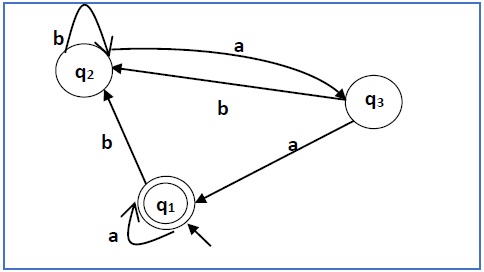
Solution −
Here the initial state and final state is q1.
The equations for the three states q1, q2, and q3 are as follows −
q1 = q1a + q3a + ε (ε move is because q1 is the initial state0
q2 = q1b + q2b + q3b
q3 = q2a
Now, we will solve these three equations −
q2 = q1b + q2b + q3b
= q1b + q2b + (q2a)b (Substituting value of q3)
= q1b + q2(b + ab)
= q1b (b + ab)* (Applying Arden’s Theorem)
q1 = q1a + q3a + ε
= q1a + q2aa + ε (Substituting value of q3)
= q1a + q1b(b + ab*)aa + ε (Substituting value of q2)
= q1(a + b(b + ab)*aa) + ε
= ε (a+ b(b + ab)*aa)*
= (a + b(b + ab)*aa)*
Hence, the regular expression is (a + b(b + ab)*aa)*.
Example:
Construct a regular expression corresponding to the automata given below −
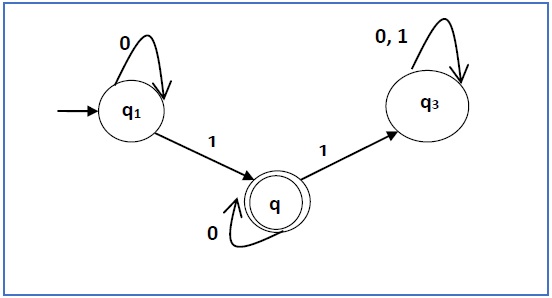
Solution −
Here the initial state is q1 and the final state is q2
Now we write down the equations −
q1 = q10 + ε
q2 = q11 + q20
q3 = q21 + q30 + q31
Now, we will solve these three equations −
q1 = ε0* [As, εR = R]
So, q1 = 0*
q2 = 0*1 + q20
So, q2 = 0*1(0)* [By Arden’s theorem]
Hence, the regular expression is 0*10*.
Example:
Construct the regular expression for the given DFA

Solution:
Let us write down the equations
q1 = q1 0 + ε
Since q1 is the start state, so ε will be added, and the input 0 is coming to q1 from q1 hence we write
State = source state of input × input coming to it
Similarly,
q2 = q1 1 + q2 1
q3 = q2 0 + q3 (0+1)
Since the final states are q1 and q2, we are interested in solving q1 and q2 only. Let us see q1 first
q1 = q1 0 + ε
We can re-write it as
q1 = ε + q1 0
Which is similar to R = Q + RP, and gets reduced to R = OP*.
Assuming R = q1, Q = ε, P = 0
We get
q1 = ε.(0)*
q1 = 0* (ε.R*= R*)
Substituting the value into q2, we will get
q2 = 0* 1 + q2 1
q2 = 0* 1 (1)* (R = Q + RP → Q P*)
The regular expression is given by
r = q1 + q2
= 0* + 0* 1.1*
r = 0* + 0* 1+ (1.1* = 1+)
PROBLEMS BASED ON CONVERTING DFA TO REGULAR EXPRESSION-
Problem-01:
Find regular expression for the following DFA using Arden’s Theorem-
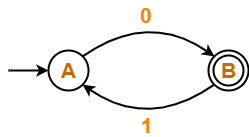
Solution-
Step-01:
Form a equation for each state-
- A = ∈ + B.1 ……(1)
- B = A.0 ……(2)
Step-02:
Bring final state in the form R = Q + RP.
Using (1) in (2), we get-
B = (∈ + B.1).0
B = ∈.0 + B.1.0
B = 0 + B.(1.0) ……(3)
Using Arden’s Theorem in (3), we get-
B = 0.(1.0)*
Thus, Regular Expression for the given DFA = 0(10)*
Problem-02:
Find regular expression for the following DFA using Arden’s Theorem-
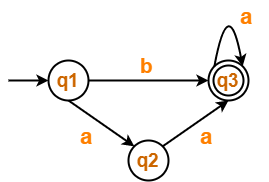
Solution-
Step-01:
Form a equation for each state-
- q1 = ∈ ……(1)
- q2 = q1.a ……(2)
- q3 = q1.b + q2.a + q3.a …….(3)
Step-02:
Bring final state in the form R = Q + RP.
Using (1) in (2), we get-
q2 = ∈.a
q2 = a …….(4)
Using (1) and (4) in (3), we get-
q3 = q1.b + q2.a + q3.a
q3 = ∈.b + a.a + q3.a
q3 = (b + a.a) + q3.a …….(5)
Using Arden’s Theorem in (5), we get-
q3 = (b + a.a)a*
Thus, Regular Expression for the given DFA = (b + aa)a*
Problem-03:
Find regular expression for the following DFA using Arden’s Theorem-
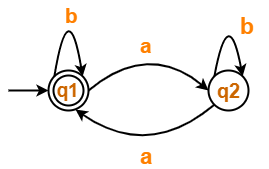
Solution-
Step-01:
Form a equation for each state-
- q1 = ∈ + q1.b + q2.a ……(1)
- q2 = q1.a + q2.b ……(2)
Step-02:
Bring final state in the form R = Q + RP.
Using Arden’s Theorem in (2), we get-
q2 = q1.a.b* …….(3)
Using (3) in (1), we get-
q1 = ∈ + q1.b + q1.a.b*.a
q1 = ∈ + q1.(b + a.b*.a) …….(4)
Using Arden’s Theorem in (4), we get-
q1 = ∈.(b + a.b*.a)*
q1 = (b + a.b*.a)*
Thus, Regular Expression for the given DFA = (b + a.b*.a)*
Problem-04:
Find regular expression for the following DFA using Arden’s Theorem-
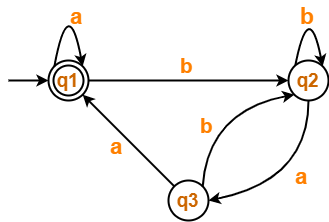
Solution-
Step-01:
Form a equation for each state-
- q1 = ∈ + q1.a + q3.a ……(1)
- q2 = q1.b + q2.b + q3.b ……(2)
- q3 = q2.a …….(3)
Step-02:
Bring final state in the form R = Q + RP.
Using (3) in (2), we get-
q2 = q1.b + q2.b + q2.a.b
q2 = q1.b + q2.(b + a.b) …….(4)
Using Arden’s Theorem in (4), we get-
q2 = q1.b.(b + a.b)* …….(5)
Using (5) in (3), we get-
q3 = q1.b.(b + a.b)*.a …….(6)
Using (6) in (1), we get-
q1 = ∈ + q1.a + q1.b.(b + a.b)*.a.a
q1 = ∈ + q1.(a + b.(b + a.b)*.a.a) …….(7)
Using Arden’s Theorem in (7), we get-
q1 = ∈.(a + b.(b + a.b)*.a.a)*
q1 = (a + b.(b + a.b)*.a.a)*
Thus, Regular Expression for the given DFA = (a + b(b + ab)*aa)*




No comments:
Post a Comment